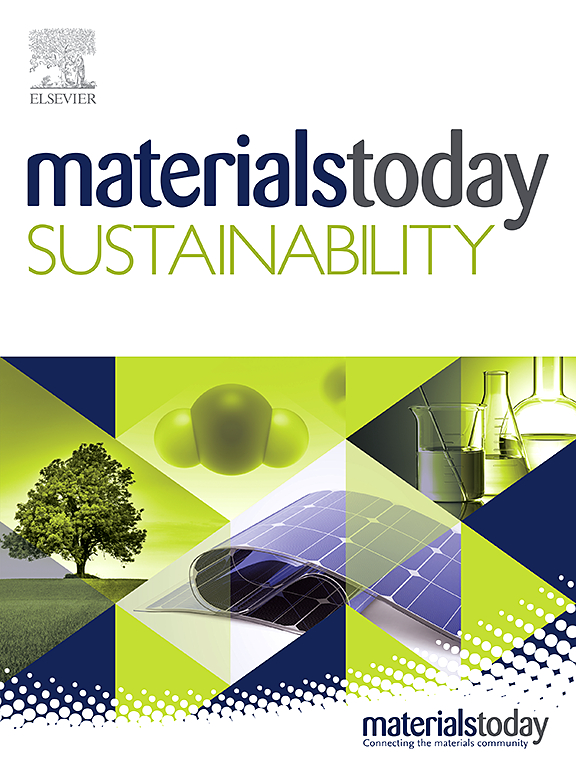Alternative energy sources from wastes and microalgae Chlorella vulgaris used for the capture of atmospheric CO2 in the production of cement
IF 7.9
3区 材料科学
Q1 GREEN & SUSTAINABLE SCIENCE & TECHNOLOGY
引用次数: 0
Abstract
This study explores the potential of using alternative energy sources as plastics (P), textiles (T), tires (A), cardboard (C), and used railway sleepers (G), combined with microalgae Chlorella vulgaris (Cho) residue in the cement production, which is one of the most energy-intensive industries globally. The algae were obtained from a photobioreactor designed for atmospheric CO2 capture. Several analytical methods were employed for the characterization of these sources, including thermogravimetric analysis (TGA) in air and nitrogen, microscale combustion calorimetry (MCC), and a combined thermogravimetric analysis with mass spectrometry (MS) and Fourier-transform infrared spectroscopy (FTIR). The waste morphology and composition were examined using scanning electron microscopy (SEM), energy dispersive X-ray spectroscopy (EDX), and attenuated total reflectance Fourier-transform infrared spectroscopy (ATR-FTIR). Thermogravimetric results indicated that adding Cho to railway sleeper waste improved combustibility, with the most favorable outcomes at a 15 % Cho mixture. MCC analysis revealed that the most efficient energy-recovery mixtures were 30Cho-P, 30Cho-T, 15Cho-G, 30Cho-C, and 45Cho-A. Furthermore, TG-MS-FTIR analysis showed that CO2 was the dominant emission, with SO2 present in tire-based mixtures and NO/NO2 in textiles ones. FTIR spectra confirmed the identification of ionic fragments in the decomposition gases, further supporting the findings on gaseous emissions from the binary waste mixtures.
从废物和微藻中获取替代能源,用于捕获水泥生产过程中的大气二氧化碳
本研究探讨了塑料(P)、纺织品(T)、轮胎(A)、纸板(C)和废旧铁路枕木(G)等替代能源的潜力,并结合微藻小球藻(Cho)残留物在全球能源密集型产业之一的水泥生产中的应用。藻类是从专为大气CO2捕获而设计的光生物反应器中获得的。采用了几种分析方法来表征这些源,包括空气和氮气中的热重分析(TGA),微尺度燃烧量热法(MCC)以及热重分析与质谱(MS)和傅里叶变换红外光谱(FTIR)相结合。利用扫描电镜(SEM)、能量色散x射线能谱(EDX)和衰减全反射傅里叶变换红外光谱(ATR-FTIR)分析了废弃物的形貌和组成。热重测试结果表明,在铁路轨枕废弃物中添加Cho可改善可燃性,其中以Cho含量为15%时效果最好。MCC分析表明,最有效的能量回收混合物为30Cho-P、30Cho-T、15Cho-G、30Cho-C和45Cho-A。此外,TG-MS-FTIR分析表明,CO2是主要排放物,SO2存在于轮胎混合物中,NO/NO2存在于纺织品混合物中。FTIR光谱证实了分解气体中离子碎片的识别,进一步支持了二元废物混合物中气体排放的发现。
本文章由计算机程序翻译,如有差异,请以英文原文为准。
求助全文
约1分钟内获得全文
求助全文
来源期刊

Materials Today Sustainability
Multiple-
CiteScore
5.80
自引率
6.40%
发文量
174
审稿时长
32 days
期刊介绍:
Materials Today Sustainability is a multi-disciplinary journal covering all aspects of sustainability through materials science.
With a rapidly increasing population with growing demands, materials science has emerged as a critical discipline toward protecting of the environment and ensuring the long term survival of future generations.
 求助内容:
求助内容: 应助结果提醒方式:
应助结果提醒方式:


